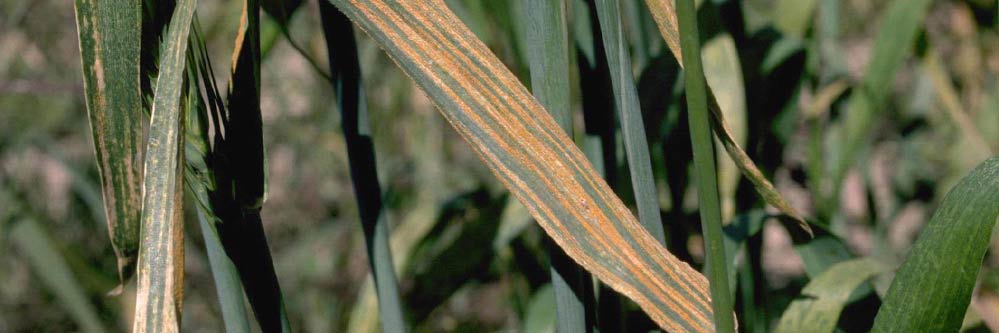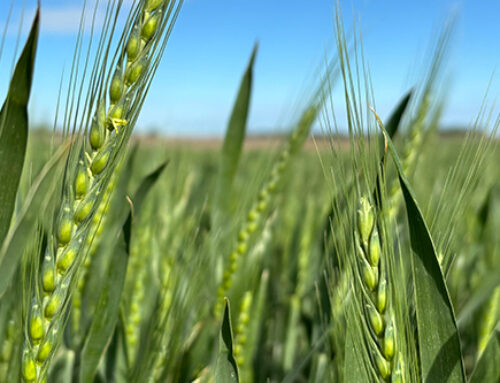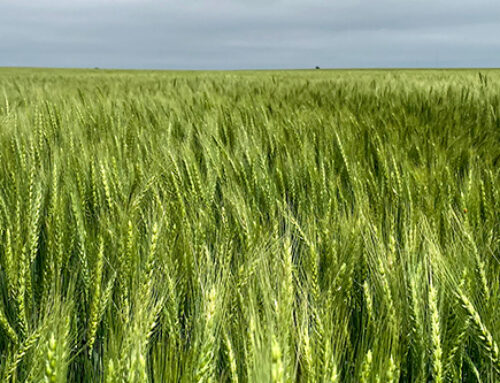Stripe rust is caused by the fungus Puccinia striiformis and is one of the most prevalent and destructive diseases of wheat in the world. It has caused major losses in wheat crops around the world for many decades, and it continues to be a problem. Kansas wheat losses from Stripe Rust have been reported up to 40% in individual fields during years with higher precipitation. In the past 10-15 years, stripe rust has become increasingly more of a problem in Southwest Kansas. According to Harlan Bartel, Crop Quest Agronomist from Cimarron, KS, some years it can almost become an epidemic, and other years there is next to nothing. In 2014, stripe rust pressure was next to nothing.
Stripe rust is one of the three major rust diseases that are prominent: stem rust, leaf rust, and stripe rust. Stripe rust is different from the other two in that the pustules usually form in a narrow and diagonal line parallel to the leaf, rather than randomly on the leaf. They are also a brighter orange in color than leaf rust, which is more brownish red. The pustules are small, and usually spherical in shape. As the infection increases, the stripes are very visible and are easily seen.
Agronomists and farmers need to be active in scouting for this disease in wheat, in order to catch it early in its lifecycle, and apply control measures before it becomes rampant. Be especially vigilant in scouting when the leaves have been wet consistently for 12 hours or more. Cool, damp conditions and high humidity are the most conducive for spore germination. The spores germinate rapidly during temperatures of 50-60 degrees Fahrenheit, with infection being seen anywhere from 32-77 degrees Fahrenheit. The spores overwinter, and are capable of surviving for several months in a living host plant. Thus, controlling the disease early on is important and vital for crop health.
If stripe rust is found, control measures should be taken before it spreads to the flag leaves. Protecting the flag leaf is very important and should be a major concern for farmers. If the infection gets on the flag leaves, it can cause severe yield loss. Spraying the field early has been shown to give the best results. Economic response in crops with high yield potential seems to be much better with early spraying than with late spraying. It is suggested that foliar fungicides be sprayed before 5% of the flag leaf area is infected with stripe rust.
There are several options and management practices that can be used to control the disease. First of all, planting resistant wheat cultivars has been effective. Selecting earlier maturing wheat varieties can minimize the intensity of the pressure. Controlling volunteer wheat minimizes many disease and insect problems. Delaying planting can reduce fall infection. Spraying fungicides is one of the most effective treatments and control options. K-State researchers have found that triazole fungicides work “very well” in most situations. Using products that contain both triazoles and strobilurins are also very effective treatment options.
Regardless of the treatment options and management practices that are implemented, it is important to be on the lookout for stripe rust early in the season, especially if weather conditions are cool and wet.
Article Written By: Abigail Bartel, 2014 Agronomist Intern, Montezuma, KS Division; Kansas State University
Featured Image By: Howard F. Schwartz, Colorado State University, Bugwood.org (5362120)





